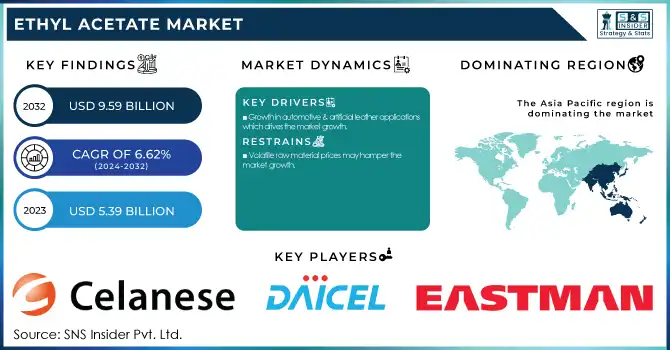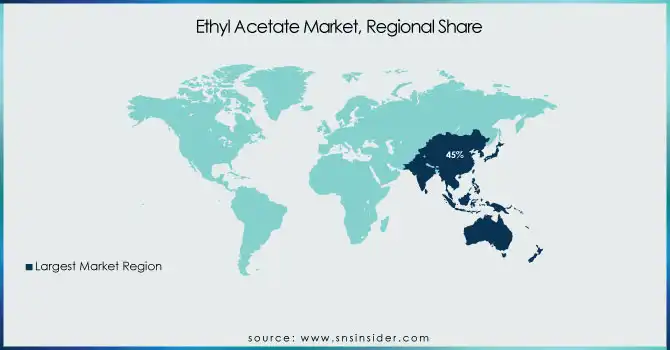Ethyl Acetate Market Report Scope & Overview:
The Ethyl Acetate Market size was USD 5.39 Billion in 2023 and is expected to reach USD 9.59 Billion by 2032 and grow at a CAGR of 6.62% over the forecast period of 2024-2032. This report provides comprehensive statistical insights and trends in the Ethyl Acetate Market, covering production capacity and utilization rates by country and type in 2023. It analyzes feedstock prices and supply chain dynamics, highlighting cost fluctuations and availability. The study examines the regulatory landscape, assessing its impact on production and usage across regions. Environmental metrics such as VOC emissions, waste management, and sustainability initiatives are detailed. The report also explores end-use demand trends in paint & coatings, inks, process solvents, and pharmaceuticals. Additionally, it covers technological advancements and R&D investments in bio-based Ethyl Acetate, reflecting market innovation.

To Get more information on Ethyl Acetate Market - Request Free Sample Report
Ethyl Acetate Market Dynamics
Drivers
-
Growth in automotive & artificial leather applications which drives the market growth.
Increasing application in automotive and artificial leather due to solvent properties is likely to accelerate the usage of ethyl acetate over the years, improving coating performance & surface quality. Ethyl acetate is extensively used in automotive paints, clear coatings, and adhesives because of its ability to vaporize quickly and is compatible with polymeric resins, thus providing a high quality and durable finish. At the same time, the manufacture of artificial leather help to ensure that synthetic fibers and polymers are brought together in such a way as to give better texture, quality, and strength of the finished product while retaining the necessary flexibility. The trend of environmentally friendly formulation and increasing environmental regulations has spurred the demand for low-VOC solvents such as ethyl acetate. This dual application across both sectors, and coupled with technological advancements in solvent usage, is helping the overall market flourish.
Restraint
-
Volatile raw material prices may hamper the market growth.
The prices of raw materials are volatile, more so for certain basic inputs (e.g., ethanol and acetic acid), which contribute to high uncertainty in production costs. Price volatility of these commodities can lead to sudden spikes in cost, and manufacturers may need to undergo a price recalibration process further reducing their margins. This uncertainty makes it extremely challenging for firms to outline investments in capacity expansion and innovation, causing market growth to stagnate. Additionally, the production costs will be higher, which means that prices for the end-user will be higher, resulting in lower overall demand and competitiveness.
Opportunity
-
Innovation in production technologies creates an opportunity in the market.
The ethyl acetate market is being opened up by innovations in production technologies (in terms of process efficiency and environmental impact). Innovations in catalytic methods and process intensification help manufacturers maximize yield by reducing the potential for waste and energy consumption (Çatal et al. This helps reduce costs as well as tightens compliance with environmental regulations which are ever-closely becoming stringent. Additionally, enhanced production methods allow better consistency and quality of the product, subsequently increasing the number of end-use applications. Moreover, digital monitoring and automation integration offer tighter control over their production parameters, which enhances their efficiency and outputs even further. These innovations can also open new feedstocks but also lessen reliance on traditional feedstock mins, thus decreasing the exposure to high price cycles.
Challenges
-
Competition from bio-based alternatives may create a challenge for the market.
The market for ethyl acetate has been progressing continually over the years. However, competition offered by bio-based substitutes is a prime restraint for the conventional ethyl acetate market. With increasing awareness towards the environment and stringent regulations, manufacturers are inclined towards bio-based solvents owing to their low VOC emissions and lesser environmental hazard. These alternatives not only fulfil the sustainability ambitions of different industry sectors but also benefit from ongoing technological development that increases their performance and cost efficiency.
Ethyl Acetate Market Segmentation Analysis
By Application
Paint & Coatings held the largest market share, around 54% in 2023. It is a key ingredient for high-performance coatings. The outstanding solvent properties of ethyl acetate allow it to dissolve resins and pigments, facilitating homogeneous disperse and short drying times, which important for high quality of the finish. Additionally, the ability to use it with so many polymers and additives makes Valley Craft even more desirable in this market. In addition to that, the ever-rising need for advanced coating solutions in construction, automotive and consumer goods sectors has further strengthened the dominance of paint & coatings segment in ethyl acetate consumption.
By End Use
Automotive segment held the largest market share around 35% in 2023. It is owing to the wide range of applications of ethyl acetate in the automotive industry, especially in coatings, adhesives, and finishes. Ethyl acetate is useful in automotive paints and coatings for its ability to evaporate quickly to facilitate application and delivery of a smooth, long-lasting finish. A resin that is freely soluble in the solvent and of sufficiently low toxicity to be an attractive production and consumer choice. Ethyl Acetate continues to play a very important role in the automotive sector owing to the fact that the automotive sector is constantly evolving in terms of aesthetic quality in a vehicle along with the functionality of a product and the search for synthetic alternatives that are eco-friendly.
By Distribution Channel
Offline segment held the largest market share around 68% in 2023. It has several established distribution networks, long-standing relationships in traditional industries, and an in-depth reach characterize the larger share of the ethyl acetate market in the offline segment. Offline sales channels like direct sales through distributors and industrial suppliers fulfill the requirements for bulk buying specific to major end-use industries including automotive, pharmaceuticals, and paints & coatings. Customers benefit from convenient access, a large inventory, and on-site technical support in these channels—imperative for continuous supply and timely delivery of chemicals. In addition, offline channels also remain popular due to in-person consultations that provide assurances that specialized products are delivered correctly.
Ethyl Acetate Market Regional Outlook
Asia Pacific held the largest market share, around 45% in 2023. It is owing to the rapid industrial growth rate and the growing manufacturing infrastructure in the region. The growth in automotive, paints, coatings, and adhesives sectors in the region is key to a robust ethyl acetate demand since the chemical plays a crucial role in quality finishing and production processes. Well-founded technology investments and many government initiatives stimulating industrialization and growth, have also added to the production capacity of these nations, especially in China and India. It also is one of the preferred production and consumption hubs in the region, driven by comparatively competitive cost structures and a well-established supply chain.
North America held a significant share market share in 2023. It is due to the R&D investments and a mature network of distribution networks provide consistent supply for quality solvents across the region. In addition, strict environmental regulations as well as rapidly increasing consumer demand for low VOC products are providing a strong push toward the replacement of ethyl acetate for various key applications, including automotive coatings, adhesives, and pharmaceuticals. The emergence of several strategic partnerships and the technological advancement in various production processes has further increased the competitiveness in the market, making North America as a gold-point for consumption and production of ethyl acetate.

Get Customized Report as per Your Business Requirement - Enquiry Now
Key Players
-
Celanese Corporation (Elvacite, Tuffak)
-
Daicel Corporation (Daijet, Celgreen)
-
Eastman Chemical Company (Eastman EA, Solusolv)
-
INEOS (INEOS Ethyl Acetate, INEOS Oxide)
-
IOL (IOL Ethyl Acetate, IOL PharmaSolv)
-
Jiangsu SOPO (Group) Co., Ltd. (SOPO Ethyl Acetate, SOPO Solvent)
-
Jubilant Pharmova Limited (Jubilant Ethyl Acetate, Jubilant PharmaSolv)
-
KAI CO. LTD. (KAI Acetate, KAI Solvex)
-
Linde PLC (Linde Ethyl Acetate, Linde Solvents)
-
Sasol Limited (Sasol Ethyl Acetate, Sasol Solvenx)
-
SHOWA DENKO KK (SDK Ethyl Acetate, SDK Solvent)
-
Sipchem (Sipchem Ethyl Acetate, Sipchem Solvent)
-
Solvay (Solvay Ethyl Acetate, Solvay Acetex)
-
Yip's Chemical Holdings Limited (Bauhinia Ethyl Acetate, Bauhinia Solvent)
-
Godavari Biorefineries Ltd. (Godavari Ethyl Acetate, Godavari BioSolv)
-
Kanoria Chemicals & Industries Limited (Kanoria Ethyl Acetate, Kanoria Solvent)
-
Sekab Biofuels & Chemicals AB (Sekab Green EA, Sekab BioSolvent)
-
Merck KGaA (Merck Ethyl Acetate, Merck Solvent)
-
Shandong Jinyimeng Group Co., Ltd. (Jinyimeng Ethyl Acetate, Jinyimeng Solvent)
-
Handsome Chemical Co., Ltd. (Handsome Ethyl Acetate, Handsome Solvent)
Recent Development:
-
In 2023, Eastman Chemical Company implemented eco-friendly production practices for ethyl acetate, focusing on sustainability and reducing environmental impact. The company also introduced advanced process technologies to improve efficiency and product quality.
-
In 2023, Celanese Corporation expanded its ethyl acetate production capacity to meet the rising market demand. This strategic move aims to strengthen its position in the global solvent market and ensure a consistent supply for key industries.
| Report Attributes | Details |
|---|---|
| Market Size in 2023 | USD 5.39 Billion |
| Market Size by 2032 | USD 9.59 Billion |
| CAGR | CAGR of 6.62% From 2024 to 2032 |
| Base Year | 2023 |
| Forecast Period | 2024-2032 |
| Historical Data | 2020-2022 |
| Report Scope & Coverage | Market Size, Segments Analysis, Competitive Landscape, Regional Analysis, DROC & SWOT Analysis, Forecast Outlook |
| Key Segments | • By Application (Paint & Coatings, Inks, Process Solvents, Pigments, Other) • By End-Use (Artificial Leather, Pharmaceutical, Automotive, Food & Beverage, Packaging, Other) • , By Distribution Channel (Offline, Online) |
| Regional Analysis/Coverage | North America (US, Canada, Mexico), Europe (Eastern Europe [Poland, Romania, Hungary, Turkey, Rest of Eastern Europe] Western Europe] Germany, France, UK, Italy, Spain, Netherlands, Switzerland, Austria, Rest of Western Europe]), Asia Pacific (China, India, Japan, South Korea, Vietnam, Singapore, Australia, Rest of Asia Pacific), Middle East & Africa (Middle East [UAE, Egypt, Saudi Arabia, Qatar, Rest of Middle East], Africa [Nigeria, South Africa, Rest of Africa], Latin America (Brazil, Argentina, Colombia, Rest of Latin America) |
| Company Profiles | Celanese Corporation, Daicel Corporation, Eastman Chemical Company, INEOS, IOL, Jiangsu SOPO (Group) Co., Ltd., Jubilant Pharmova Limited, KAI CO. LTD., Linde PLC, Sasol Limited, SHOWA DENKO KK, Sipchem, Solvay, Yip's Chemical Holdings Limited, Godavari Biorefineries Ltd., Kanoria Chemicals & Industries Limited, Sekab Biofuels & Chemicals AB, Merck KGaA, Shandong Jinyimeng Group Co., Ltd., Handsome Chemical Co., Ltd. |

